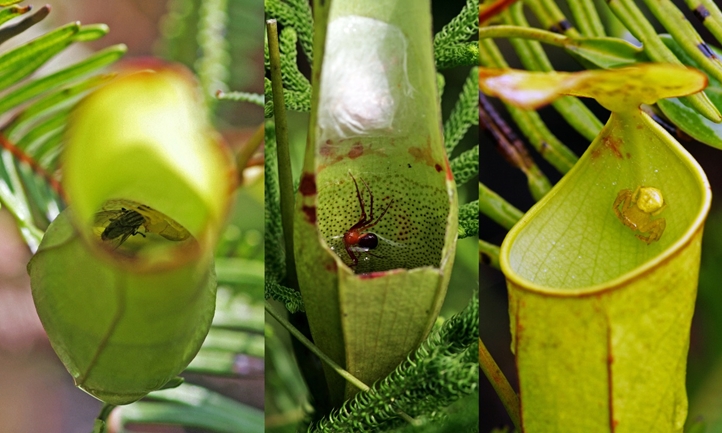A mutually beneficial relationship between two “predators”
NUS ecologists have discovered that a species of crab spider which lives in carnivorous pitcher plants attacks flies to provide supplementary nutrients for its host.
The slender pitcher plant (Nepenthes gracilis) is native to Singapore, and often grows on poor soils, supplementing its nutrient requirements by trapping and digesting insect prey using modified leaf structures known as pitchers. Pitchers are like pitfall traps. They do not move, but use sweet nectar as bait and slippery inner walls to trap crawling insects which fall into the fluid at the bottom of the pitcher. These trapped insects drown and are digested by the plant. Occasionally, flying insects are trapped as well, but pitfall traps are generally more efficient at trapping crawling ones.
A research team comprising Prof Hugh TAN and his Ph.D. student, Mr LAM Weng Ngai from the Department of Biological Sciences, NUS has discovered that the pitcher-loving crab spider (a literal translation of its scientific name, Thomisus nepenthiphilus) attacks flies visiting the mouth of the slender pitcher plant and drops their carcasses into the pitcher’s fluid after sucking their body fluids out. This results in more flies being “trapped” by pitcher plants inhabited by these pitcher-loving crab spiders, than those without. However, flies that have been consumed by spiders release less nutrients to the pitcher plants. This trade-off means that although the pitcher-loving crab spider is “stealing” from the pitcher plants by attacking flying insects that visit them, the net effect of this burglary can still be beneficial to plants. This is only when there are limited insect prey around. The pitcher-loving crab spider is found only in the pitchers of the slender pitcher plant, and is one of many specialised organisms that are able to live comfortably within these insect-eating pitchers. Very little is known about the pitcher-loving crab spider, and this study is the first to describe its foraging behaviours, and the effect of this behaviour on its host plant.
Mr Lam said, “The effect of this crab spider on the slender pitcher plant, are context-dependent. This means that the beneficial effects of the interaction are lost when the situation changes, such as when there are plenty of insect prey.”
“The research provides an important insight into the kinds of circumstances that favour cooperation over parasitism, and is an important step forward in attaining a better understanding of these interactions. The team has also examined the effect of crab spider occupation on the prey capture rates of pitcher plants in their natural environments, and are in the process of finalising these findings,” added Prof Tan.

Figure shows (left) the pitcher-loving crab spider (Thomisus nepenthiphilus) with flesh fly prey in a pitcher of the slender pitcher plant (Nepenthes gracilis). (Middle) Another species of pitcher-dwelling crab spider (Misumenops nepenthicola) with a silk nest constructed on the inner wall of a Nepenthes gracilis pitcher which has been cut open. (Right) The pitcher-loving crab spider (Thomisus nepenthiphilus) waits for visiting insect prey in a Nepenthes gracilis pitcher.
Reference
Lim RJY; Lam WN*; Tan HTW, “Novel pitcher plant–spider mutualism is dependent upon environmental resource abundance” OECOLOGIA Volume 188, Issue 3, pp 791–800 DOI: 10.1007/s00442-018-4246-8 Published: 2018.
